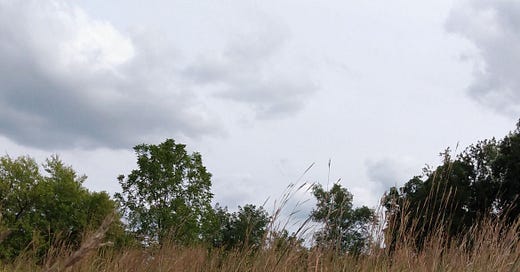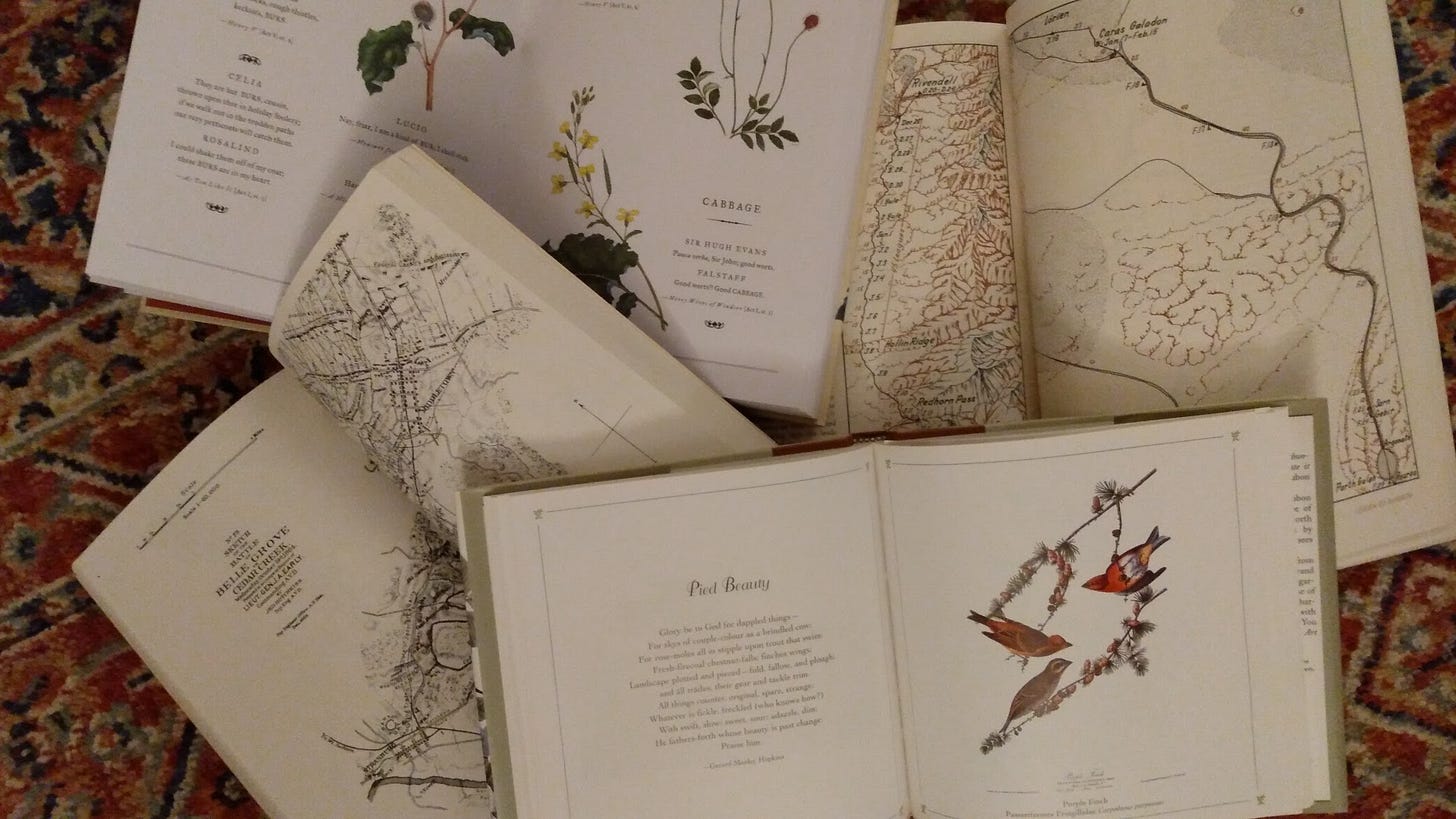When asked what hobbies I enjoy, I am often tempted to rattle off a list of things I’ve done here or there, or things I aspire to do more. But if I am honest with myself and assess my hobbies based on those activities I enjoy most often, there are two easy answers. I either read inside with a cup of tea and a cozy blanket, or I lace up my shoes or boots to go for a walk or hike, most frequently when it is early morning, dusk, a little too cold, windy, or raining.
I think of this as the Bilbo Baggins paradox. Like Bilbo, I sometimes feel like a foolhardy adventurer, but other times I am merely a simple homebody. My desires alternate between wanting to disappear into the wilderness and thinking about making another cup of tea from the comfort of home.
But maybe enjoying reading and walking as my primary hobbies isn’t really a paradox after all. Indeed, somehow reading and walking seem to be woven together, and perhaps even inseparable. As I ponder this paradox while writing, the more I’m becoming convinced that divorcing them from each other seems to reduce the fullness of each. Let’s delve a little deeper.
First of all, to read well, one must properly learn to walk the paths of life. An attentive reader must be at peace with someone else leading them. They must pay attention to patterns, notice changes, and listen for cues given by the writer. In our modern world where an instant buzz is always a swipe away, a reader must retrain their attention span so that they can complete the marathon of finishing a heavy volume. Walking does each of these things beautifully. To walk on any trail is to permit someone else to take the lead and choose the way for you. Additionally, walking outside, whether in a remote forest or a neighborhood, we learn to see patterns emerge. We hear a noise in the trees and look up to see a gang of vultures biding their time for the next prey. We notice the progress our neighbor is making on the fence he is building, or at exactly which point in the road a neighbor’s dogs will notice our presence and begin barking. Walking opens our minds and allows us to once again pay attention to simple things for sustained periods of time. Attempting to whittle down our reading lists without exercising our bodies in nature will likely leave us disappointed at our inability to enjoy the story and focus on our book. So if you want to read well, start by taking a walk.
Likewise, to walk well, one must first know how to enter new lands with the spirit of adventure. By necessity, a skilled walker must have the mind of an adventurer. Undaunted by the cold or the rain, a passionate walker sees the world as a place for connection, both to those inhabiting it in the present, and those who dwelt before in the past. A walker sets off into the world to see it with new eyes. These are both the eyes that see the wild goldenrod and the yapping lap dogs, as well as the eyes of the mind. Walking allows both our legs and our minds to wander new paths. The habit of reading helps to achieve each of these skills needed for walking. Each time we open a new book, we are taking on a new journey, a new adventure to uncharted lands. We do not know where the author will take us, or if the book will be sunny or stormy. We press onward, driven by the promise of the end. As we read, we watch the narrative unfold and smile with satisfaction at the allusions and connections woven throughout. While reading The Far Side of the World by Patrick O’Brian earlier this year, I realized that the book was written almost 50 years ago, but the plot is set over 200 years ago and features a character who is reading The Iliad, which I’ve read. Time is of little essence here. The same words resound throughout the years, they continue to inspire and elevate our souls, just as the mountains and valleys we inhabit beckon us to explore paths taken by those who came before.
In addition to training us in the mentality of an explorer, reading can literally light a spark of adventure within us. From the warmth and comfort of our home, we spend hours poring over books of maps, travel companions, nature journals, survival stories, and tales of imaginary realms. As we grab another pillow for the armchair and make another cup of tea, we decide that we should definitely tackle that daunting trail this weekend. Feeling the tangible pages1 beneath our hands seems to beckon us to step out into the world and exchange them for the rough bark of a towering tree. Read enough books and you’ll inevitably end up walking through nature. It’s easy to forget, but you know, books are trees.
Reading and walking both connect us to the past, present, and future. They connect us to the community we inhabit physically, as well as the community we inhabit intellectually. When we read a book, we enter the world of yesterday. Maybe the book was written this year, or maybe it was written a few thousand years ago. Either way, the words we read connect us to the past. Likewise, each path we take as we walk also connects us to the past, whether the recent, or ancient past. We tread the pages and paths of the past in the present, so that we may learn how to continue into the future.
Perhaps my argument is merely a way for me to justify my two favorite pastimes. In spite of all that I’ve said, maybe it is true that you can read well without walking and walk well without reading. But in my experience, the more I wander through nature, the easier it is to wander through the books accumulating on my shelves. And the more books I read, the more I want to get out into the world and learn to love every stone, tree, and summit within my line of vision.
If you aren’t convinced yet, I ask you to take a leap of faith and try weaving reading and walking together in your daily life. Listen to the words reverberate in your mind with each footstep you take. Think about the places inhabited by the characters in the book you are reading. Where do the characters walk? Where did the author walk? Writers can take us to places we’ve never been, down paths we’ve only seen in our minds. Bring the experience of your walks and hikes into the books you read. Feel the dirt and stones the characters feel. Bring the words of the past into the paths of the present. Find books written by authors who lived where you lived. Journey into the past of your town and then bring those memories into the present.
Learn to walk the pages of the books on your shelf. Learn to read the paths beneath your feet.
The books pictured above are Botanical Shakespeare, The Atlas of Middle Earth, Make Me a Map of the Valley, and Audubon’s Art and Nature.
Permit me to go on a tangent for a moment. As helpful as eBooks might be, they are not supplements for a physical book, and will always yield a lesser experience to the reader. A book is a fully sensory experience. We see the words, we hear the sound of the page turning, we feel the smooth pages, and the worn cover, we smell the glue and the mustiness. Furthermore, reading a physical book in public makes our intellectual life an “open book.” It sparks conversations with strangers and invites connection. Read a book. A physical book. Learn how it feels, how it sounds. Love each page, even when you spill your tea, or find a dead spider inside the pages (yes, this has actually happened to me multiple times).






I love this. As a novelist I get all my ideas either walking or reading. My latest one takes place in the town of my ancestors. I’ve spent hours walking the same dirt roads as the people I write about and have spent even more hours reading about people like them who lived quiet rural lives and served in old wars. It’s a shame that some people don’t take the advice you give. These two practices led me to my calling.